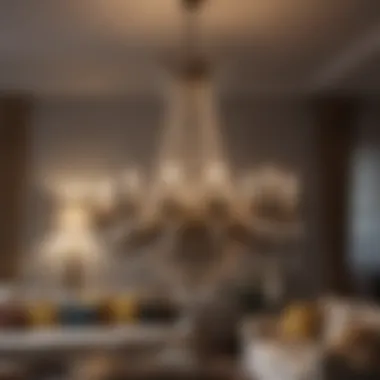Choosing the Perfect Chandelier for Your Living Room


Intro
Choosing a chandelier for your living room is not simply about adding a light fixture. It is about making a statement and enhancing the overall atmosphere of the space. The right chandelier can draw the eye, set the mood, and even function as a conversation starter. The importance of this decision cannot be overstated.
When considering the perfect chandelier, various factors come to light, such as design principles, spatial considerations, and style choices. In addition, understanding the nuances of different materials and the ongoing maintenance can significantly influence your final decision. In this guide, we will explore these aspects in detail, aiming to provide you with the knowledge needed to make an informed selection.
Design Inspiration
Trending Styles
The style of a chandelier largely dictates the ambiance it creates. Currently, these styles are gaining popularity:
- Modern: Characterized by sleek lines and minimalistic designs, modern chandeliers often use materials like metal and glass.
- Industrial: This style embraces a raw and unfinished look, prominently featuring Edison bulbs and reclaimed materials.
- Traditional: Featuring intricate designs and classic motifs, traditional chandeliers are often adorned with crystals or elegant glass.
- Bohemian: Colorful, eclectic, and often made from natural materials, bohemian-style chandeliers add a unique personal touch to the living room.
Whether you prefer something chic or ornate, it is vital to select a style that suits both your taste and the existing decor.
Color Palettes
Color plays an essential role in a chandelier’s visual impact. Consider the following guidelines when choosing a color palette:
- Match the colors to the existing room scheme. If your living room features neutral tones, a bold chandelier can serve as a stunning focal point.
- If your decor includes vibrant colors, consider a chandelier that complements this palette without overpowering it.
- Metal finishes such as gold, silver, or bronze can also affect how the light is perceived in the room, changing the overall aesthetic.
"A well-chosen chandelier serves not only as a source of light but also as an integral part of the room's identity."
Practical Tips
Maintenance & Care
To ensure the longevity and brilliance of your chosen chandelier, proper maintenance is crucial. Here are some essential tips:
- Regularly dust the fixture to avoid buildup. Use a soft cloth or a feather duster to gently remove dust.
- Check for loose bulbs and replace them promptly. This keeps your chandelier looking its best.
- For crystal chandeliers, consider using a gentle cleaning solution that won’t damage the shine.
Budgeting & Planning
Setting a budget is a practical step in your chandelier-selection journey. Here are some steps to consider:
- Determine your overall budget. Factor in installation costs, which might require hiring a professional.
- Research various options, comparing prices across different stores and online platforms.
- Allocate funds for maintenance. Each chandelier has different care needs that may impact your budget over time.
Understanding Chandelier Functionality
Choosing the right chandelier involves more than just selecting a visually appealing fixture. Understanding chandelier functionality is essential for achieving both aesthetic harmony and optimal lighting within the living room. A chandelier serves as a focal point in the room, influencing the overall ambiance and contributing to the room's character.
The benefits of a well-chosen chandelier extend beyond lighting. It can enhance architectural features and complement furnishings. A chandelier often showcases personal style, reflecting taste and sensibility. Therefore, familiarity with its versatility and application can guide homeowners to make informed decisions regarding size, type, and placement. Such understanding encourages the creation of a cohesive design that balances functionality with artistry.
The Role of a Chandelier in Interior Design
A chandelier is more than just a light source; it acts as a statement piece within interior spaces. Its presence can alter perception of size and proportions in a room. Placing a chandelier in the right spot can enhance the elegance of a living area, drawing attention to significant aspects of the decor. Furthermore, chandeliers come in various styles, drawing from periods and cultures. This variety allows for personalization, making it easier for homeowners to create a unique atmosphere in their living rooms.
Additionally, the chandelier can provide character to otherwise ordinary spaces. In effect, it becomes an essential element of design, contributing light and style. Selecting the appropriate chandelier means considering one’s design vision while ensuring it meets illumination needs.
Types of Lighting: General vs. Accent vs. Task
When selecting a chandelier, understanding different types of lighting is critical. General lighting provides overall illumination, serving as the primary source of light in the room. Chandeliers often fulfill this role, bathing the space in ambient brightness. To achieve this, they may use multiple bulbs for comprehensive coverage; for example, a traditional crystal chandelier can create a warm, inviting glow through the refractive qualities of glass.
In contrast, accent lighting directs attention towards specific objects or areas. This kind of lighting highlights artwork, decorations, or architectural features. Choosing a chandelier that facilitates accent lighting can augment these focal points, creating visual interest and depth.
Task lighting, on the other hand, serves functional purposes. This type of lighting illuminates areas designated for specific activities, such as reading or crafts. Customizing chandelier height and brightness can adapt it for task-oriented use. However, for effective task lighting, supplementary fixtures may still be necessary to meet varied illumination needs in the living room.
Understanding these lighting types allows for thoughtful chandelier selection that fulfills both necessity and design intent.
Assessing Living Room Space
Assessing the living room space is crucial when selecting a chandelier. The right chandelier harmonizes with the area, enhancing the room's aesthetic and functionality. Careful evaluation helps you avoid common mistakes and ensures that the chandelier fits well within your space. Additionally, it influences the overall ambiance; an appropriately sized and placed chandelier not only illuminates but also adds a focal point to the decor.
Measuring Ceiling Height
Measuring the ceiling height is one of the first steps in ensuring a successful chandelier choice. The height of the ceiling dictates how low or high the chandelier can be hung. For standard ceiling heights, a general guideline is to allow at least seven feet of clearance below the fixture. In rooms with higher ceilings, such as those over nine feet, you may require a larger chandelier that extends downwards more than usual.
To measure accurately:
- Use a tape measure to determine the height from the floor to the ceiling.
- Consider the hanging style of the chandelier; for example, a cascading chandelier may require additional vertical space.
- Factor in your room’s overall vibe; an oversized chandelier may look grand but can overbearing if the room is not large enough.
Evaluating Room Dimensions and Layout
After considering ceiling height, evaluating the room dimensions and layout becomes paramount. This helps in selecting a chandelier that not only fits the aesthetics but also integrates seamlessly into the space.


- Room Width: The diameter of the chandelier should ideally be one-third of the room's width. This proportion results in a balanced look that is visually pleasing.
- Room Length: Similarly, measure the room's length. A long room may benefit from a linear chandelier or multiple fixtures that together create a cohesive lighting scheme.
- Furniture Arrangement: Analyze how furniture is arranged in your living room. The chandelier must not obstruct views or clash with large pieces such as sofas or coffee tables. Positioning it relative to seating arrangements maximizes its utility and appeal.
In summary, assessing the living room space—measuring ceiling height and evaluating dimensions and layout—is a foundational step in choosing the right chandelier. It ensures that the fixture complements the room's characteristics while enhancing its design and function.
Choosing a Chandelier Style
Selecting the right chandelier style is crucial in achieving a harmonious and aesthetically pleasing living room. The chandelier serves not only as a lighting fixture but also as a statement piece that can influence the entire atmosphere of your space. A well-chosen chandelier can elevate the decor, complement color schemes, and reflect personal style.
When choosing a chandelier style, you should consider how it fits with the existing decor elements. This ensures you create a cohesive environment that speaks to your taste and complements the functionality of the room. Additionally, a chandelier often occupies a central position, making its style even more impactful in the overall design narrative.
Traditional vs. Contemporary Designs
Traditional chandeliers often exude elegance and timelessness. They feature ornate details, such as crystal accents or intricate metalwork, which often remind one of classic architecture. In contrast, contemporary chandeliers lean towards minimalism, showcasing sleek lines and innovative shapes.
- Benefits of Traditional Styles:
- Benefits of Contemporary Styles:
- Often associated with grandeur and luxury.
- Versatile with classic decor themes.
- Can include grand elements that serve as conversation starters.
- Offers clean aesthetics that blend well with modern furniture.
- Designed to be functional while looking artistic.
- Variety of materials used, such as metal and glass, makes them adaptable to various styles.
Ultimately, the choice between traditional and contemporary designs will depend on the look you wish to achieve in your living room. Ask yourself if you want to convey a feeling of historical richness or modern sophistication.
Eclectic and Bohemian Options
For those inclined towards personal expression, eclectic and bohemian chandelier options provide an opportunity to choose unique pieces that tell a story. These styles often combine various materials and colors, allowing for a more relaxed and informal ambiance. The allure of eclectic designs lies in their unexpected combinations, like metal with wood or colorful glass.
- Benefits of Eclectic Styles:
- Benefits of Bohemian Styles:
- Great for expressing a personal narrative.
- Can accommodate various decor themes, from vintage to artsy.
- Often made with reclaimed materials, contributing to sustainability.
- Promote warmth and a relaxed vibe and appeal easily in casual settings.
- Vibrant colors and unique shapes add visual interest to the room.
- These options often incorporate nature-inspired elements, providing a connection to the outdoors.
When choosing a chandelier, consider how the aesthetic aligns with your lifestyle and the feel you wish to cultivate. The chosen style should complement not only your existing furniture and color palette but should also resonate with your personal taste.
Material Considerations
When selecting a chandelier for your living room, the material of the fixture plays a crucial role in both aesthetic appeal and functionality. Understanding different materials allows homeowners and design enthusiasts to make informed choices that complement their space while also considering durability and maintenance. The choice of material affects not only the chandelier's appearance but also its weight, installation requirements, and the type of ambiance it creates.
Different materials can enhance the overall design theme of a living room. Some materials might evoke a sense of opulence, while others may offer a more subdued elegance. Therefore, considering the material upfront is important in achieving the desired look and feel of the room.
Metal: Brass, Chrome, and More
Metal chandeliers have long been favored for their strength and enduring design. Each type of metal offers distinct characteristics, impacting both style and upkeep.
- Brass: Known for its warm tone and classic appeal, brass can add a touch of vintage elegance to a space. It tends to age gracefully, developing a patina that some find appealing. However, cleaning brass may require special care to maintain its luster.
- Chrome: Chrome offers a sleek, modern look that reflects light beautifully. Its shiny surface can make spaces appear larger and more open. One downside is that it can show fingerprints and smudges easily, necessitating regular cleaning.
- Iron: Iron is a heavier, robust option that lends itself well to industrial or rustic decor. While it is extremely durable, its weight can impact installation logistics. Additionally, iron may rust if not coated properly, which makes maintenance a consideration.
Glass: Crystal, Frosted, or Clear
Glass is another popular material choice for chandeliers, each type serving different decorative purposes. The glass used in chandeliers can significantly influence light diffusion and overall atmosphere of the room.
- Crystal: Crystal chandeliers are celebrated for their ability to refract and disperse light, creating a sparkling effect that adds glamour. They tend to be more expensive and may necessitate more maintenance to keep them dust-free and shining.
- Frosted Glass: This option provides a softer light, perfect for creating a cozy atmosphere. Frosted glass can obscure the bulbs, which is often desirable for homeowners seeking a gentler lighting effect instead of stark brightness.
- Clear Glass: Clear glass chandeliers are versatile and can fit almost any design aesthetic. They allow maximum light to pass through, which can brighten even darker rooms. However, they will require regular cleaning to prevent dust buildup from being visible.
By carefully considering the materials used in chandeliers, homeowners can not only enhance their living room's aesthetic but also ensure the longevity and functionality of their lighting fixture. Each material brings its own set of advantages and potential drawbacks, thus making it essential to weigh these factors against personal style and maintenance preferences.
"Selecting the right material for your chandelier can significantly influence the overall design and functionality of your living space. Understanding these materials enhances decision-making."
Choosing the right fixture in terms of material is one step in the intricate process of creating a cohesive decor that reflects personal taste and meets practical needs.
Size and Scale of the Chandelier
Choosing the right size and scale for a chandelier is a critical step in ensuring it enhances the overall aesthetics of your living room. An appropriately sized chandelier will not only fit the space correctly but also serve as a focal point that captivates the interest of anyone entering the room. It is crucial to understand that the size and scale go beyond mere measurements; they involve a relationship with the surrounding environment.
Determining the Right Diameter
To determine the ideal diameter of your chandelier, start by measuring the dimensions of the room. A common guideline is to add the length and width of the room in feet, then convert that sum to inches. For example, a room measuring 12 feet by 14 feet gives a total of 26 feet; thus, a chandelier diameter of approximately 26 inches would be suitable.
However, this rule can be adjusted based on the ceiling height and the style of the room. Higher ceilings allow for larger diameters, while lower ceilings might require a more modest size. Additionally, the chandelier should not overwhelm the space, so consider other elements in the room, such as furniture, fixtures, and decor. Here are other factors to consider:
- Open Space: In rooms with open layouts, a larger chandelier may help define the living area.
- Proportion: The scale should match or complement the size of the furniture to maintain balance.
Height Considerations and Design Guidelines
The height at which a chandelier is hung is as significant as its diameter. A typical recommendation is to maintain a distance of 7 to 8 feet from the floor to the bottom of the fixture. This ensures adequate clearance while allowing the chandelier to shine without obstructing sightlines.
Adjustments may be needed depending on specific conditions:
- Dining Areas: If the chandelier is over a dining table, consider lowering it by a few inches to enhance the dining experience.
- Visual Flow: Ensure that the light fixture does not disrupt the visual flow of the room. If the space has artwork or other focal points, position the chandelier to enhance them rather than detract.


"The right size and scale of a chandelier can seamlessly tie together the room’s decor, contributing to a cohesive and inviting atmosphere."
Taking the time to carefully assess both diameter and height will pay off in the long run. Keep in mind that your chandelier should contribute to the ambience you aim to create while also serving its functional purpose.
Color and Finish Choices
Choosing the right color and finish for your chandelier can significantly affect the overall feel of your living room. These elements contribute not just to aesthetic appeal but also to how well the fixture harmonizes with existing decor. A chandelier should not only illuminate but also enhance the space, creating a cohesive visual experience. Finding the perfect balance in color and finish helps establish the mood and style of your room.
Coordinating with Living Room Color Schemes
When selecting a chandelier, it is vital to consider the existing color palette of your living room. The chandelier should complement or contrast effectively with the wall colors, furniture, and other decor elements. Here are some strategies to ensure coordination:
- Assess Color Undertones: Understanding the undertones of your room's colors is essential. For example, if your living room features warm tones like beige or soft yellow, a chandelier with a similar warm finish, such as gold or brass, will enhance unity.
- Use Color Theory: Applying principles of color theory can aid in coordination. Complementary colors, for instance, can create a striking visual effect. A blue living room can benefit from a warm-toned chandelier to evoke balance.
- Consider the Mood: The color choice can also suggest a mood. Soft, muted colors typically promote a calming atmosphere, while bold, bright colors can energize the space. Think about what kind of ambiance you wish to create.
- Sample Before Purchasing: If possible, hold swatches or samples next to the chandelier to visualize its impact in your living room.
Selecting Finishes that Complement Decor
The finish of a chandelier plays a crucial role in determining its compatibility with other decor elements in the room. Different finishes can evoke different styles and moods. Here are some considerations for selecting the right finish:
- Match Existing Hardware: If your living room features specific metals, such as stainless steel handles or knobs, matching the chandelier's finish can create a cohesive look. This attention to detail enhances the overall design.
- Select the Right Texture: Smooth and polished finishes offer a modern flair, while antiqued or textured finishes can convey a more traditional or rustic feel. Consider the overall design ethos of your living room when choosing the texture of your chandelier.
- Adapt to Lighting Needs: The finish also influences how the light diffuses in the room. For instance, frosted finishes can soften and diffuse light, creating a warm atmosphere. Conversely, clear finishes can make the space feel brighter and more open.
- Practical Considerations: Keep maintenance in mind. Some finishes may require more upkeep to stay looking fresh, while others may hide dust and grime more effectively. Evaluate your willingness to maintain the chandelier's appearance before making a final decision.
"A well-chosen chandelier will do more than light the room; it will define the space and reflect the owner's taste."
By thoughtfully considering colors and finishes, you can ensure that your chandelier becomes a highlight of your living room while supporting the intended design objectives.
Illumination and Bulb Selection
When selecting a chandelier for your living room, the aspect of illumination is crucial. The right lighting not only enhances the ambiance but also impacts the functionality of the space. Choosing the appropriate bulbs can significantly affect how the chandelier fulfills its role. Maintaining a balance between aesthetics and practicality requires an understanding of various types of bulbs and their performance characteristics.
Types of Bulbs: Incandescent, LED, and More
Choosing the correct type of bulb greatly influences both illumination and energy consumption. Common options include:
- Incandescent Bulbs: These are traditional bulbs known for their warm glow, giving a cozy feel. However, they consume more energy and have a shorter lifespan compared to other types.
- LED Bulbs: This option is gaining popularity due to its energy efficiency and long lifespan. LED bulbs produce less heat and offer various color temperatures, enhancing versatility in lighting design.
- Halogen Bulbs: A type of incandescent bulb, halogen lights are more energy-efficient and have a longer lifespan. They provide bright light and can enhance colors, making them suitable for accent lighting.
- CFL Bulbs: Compact fluorescent lamps are more energy-efficient than incandescent bulbs. However, they take time to warm up and may not provide the same quality of light immediately.
Each bulb type has distinct merits and limitations. A careful selection based on your room’s specific needs will optimize overall lighting quality.
Calculating Lumens for Adequate Lighting
To achieve the desired lighting level in your living room, it's essential to calculate lumens effectively. Lumens measure how much light is emitted by a bulb. The greater the lumens, the brighter the light. Here are some factors to consider:
- Room Size: Measure the area of your living room to establish the total lumens required. Generally, a living room needs about 10-20 lumens per square foot.
- Ceiling Height: Higher ceilings may require additional lumens to ensure the light spreads effectively throughout the room.
- Layered Lighting: Consider multiple light sources, such as chandeliers, table lamps, and floor lamps, to create a balanced lighting environment.
- Task vs. Ambient Lighting: Different activities may require different levels of brightness. For instance, reading areas may need more illumination than a general social area.
Ultimately, understanding lumens helps in achieving adequate and effective lighting with your chandelier.
Important: Using the right type of bulbs and appropriate lumens can lead to significant energy savings and an improved atmosphere in your living space.
Installation and Placement
Selecting the right chandelier is not only about aesthetics but also about understanding the practical aspects surrounding installation and placement. The significance of this topic lies in ensuring that the chosen fixture not only complements the decor but also performs optimally in its role as a lighting source. A well-placed chandelier can transform the ambiance of a living room, while poor installation may lead to safety issues or ineffective lighting. By considering specific elements like room design, electrical requirements, and overall layout, homeowners can enhance the effectiveness of their chandelier.
Hiring Professionals vs. DIY Installation
When it comes to installation, homeowners face a choice between hiring professionals or undertaking the task themselves.
Pros of Hiring Professionals:
- Expertise: Professional electricians have the skills necessary to handle any complications that may arise.
- Safety: Installing a chandelier often involves working with electrical wiring, which can pose hazards if not handled correctly.
- Warranty: Many professional installers offer warranties on their work, providing peace of mind.
Cons of Hiring Professionals:
- Cost: Professional services can be expensive, impacting overall budget for the chandelier.
Pros of DIY Installation:
- Savings: Performing the installation yourself can save money on labor costs.
- Personal Satisfaction: Successfully completing installation can be rewarding.
Cons of DIY Installation:
- Risk: Without proper knowledge, mistakes can lead to malfunction or accidents.
- Time-Consuming: DIY can take longer, particularly if unexpected issues arise.
It is essential to weigh these factors carefully. Homeowners with some experience in electrical work may feel confident tackling the job themselves. However, if there is any uncertainty, hiring a qualified professional could be the better choice.
Positioning within the Living Room Layout
The placement of a chandelier within the living room should account for both its function and aesthetic appeal. There are several considerations to keep in mind:
- Centering Over Key Areas:
- Height from Flooring:
- Avoiding Obstructions:
- Alignment with Room Features:
- Consider the Overall Scale:


- The chandelier should be centered over the main seating area or dining table. This position ensures that light coverage is adequate where it is most needed.
- It is important to position the chandelier at a height that allows for safe movement. A common guideline is to hang it 7 to 8 feet above the floor.
- Ensure that the chandelier does not obstruct views or the flow of movement within the room.
- Aligning the chandelier with architectural features such as windows or beams makes for a cohesive look.
- The size of the chandelier should correlate with room dimensions to ensure that it is visually balanced.
By addressing these elements in the positioning of the chandelier, homeowners can maximize both its aesthetic and functional attributes, resulting in a harmonious integration into the overall living room design.
"A well-placed chandelier can enhance the character of a living room while providing essential illumination. The choice of installation should reflect not only personal skill but also safety and functionality."
Maintenance and Cleaning
Maintaining and cleaning a chandelier is essential for preserving its aesthetic and functional qualities. Regular attention to these aspects not only helps prolong the life of the fixture but also enhances the overall ambiance of the living room. Dirt, dust, and grime can accumulate over time, dulling the material finishes and reducing the effectiveness of the lighting.
Chandeliers are often central elements in a room's design. Their shine and brilliance contribute significantly to the overall decor. Therefore, a well-maintained chandelier can elevate the impression of sophistication and style in your living space. This section will highlight crucial practices to maintain your chandelier as well as effective cleaning techniques tailored to various materials.
Regular Maintenance Practices
Regular maintenance practices can prolong the lifespan of a chandelier. Here are some key points to consider:
- Inspect Connections: It is advisable to periodically check the electrical connections to ensure safety and functionality. Loose connections could lead to flickering or erratic lighting.
- Tighten Loose Parts: Over time, components of the chandelier may loosen, especially after several uses. Running a simple inspection on a regular basis to tighten screws, arms, and other parts can be beneficial.
- Check for Bulb Performance: Monitor the performance of bulbs regularly to avoid unexpected outages. Replace any burnt-out bulbs promptly to maintain both light quality and aesthetic appeal.
- Environment Awareness: Factors such as humidity and proximity to cooking areas may influence how quickly dust and grime build up. Take inventory of your surroundings and adjust your maintenance schedule accordingly.
- Seasonal Cleaning Schedule: Establishing a cleaning routine at least twice a year can greatly aid in keeping the chandelier looking its best.
Cleaning Techniques for Different Materials
The cleaning techniques for a chandelier depend largely on the materials used in its construction. Below are some effective methods tailored to specific materials.
- Metal Chandeliers: For brass or chrome fittings, a mixture of warm water and mild soap can work well. Use a soft cloth or sponge to wipe down the surfaces. Avoid abrasive cleaners, as they can scratch the finish.
- Crystal Chandeliers: These require more delicate handling. It is advisable to use a solution of water and vinegar. Dip a microfiber cloth into the solution and carefully wipe each crystal piece. Spraying the solution on, then wiping with a dry cloth can enhance shine without streaks.
- Glass Chandeliers: For these constructions, a simple glass cleaner can suffice, but ensure it doesn't contain ammonia. Spray the cleaner on a soft cloth and gently wipe the surfaces.
- Avoid Harsh Chemicals: Regardless of the material, avoid aggressive cleaning agents that can damage the finish or affect the integrity of the chandelier.
With consistent maintenance and appropriate cleaning practices, your chosen chandelier can stay vibrant and striking in your living room for years to come.
By implementing a regular maintenance routine and using the right cleaning methods for the material of your chandelier, you can ensure that it remains a focal point in your living room, both beautiful and functional.
Budget Considerations
When selecting a chandelier for your living room, budget considerations play a vital role in the decision-making process. Establishing a clear budget can help narrow down choices, ensuring that selections align with personal financial capabilities. A well-defined budget allows homeowners to prioritize features and styles that resonate with their aesthetic while still adhering to practical limitations. Moreover, understanding the financial implications of chandelier selection can prevent overspending and the associated stress that comes with it.
Setting a Realistic Budget for Lighting
Setting a realistic budget involves assessing one's financial landscape. Factors such as overall interior design goals, existing decor, and long-term plans can influence how much one should spend on lighting. For instance, a luxurious glass chandelier can provide a striking focal point, yet it may also come with a higher price tag. Here are some steps to establish a workable budget:
- Assess Priorities: Identify if the chandelier is a centerpiece or a complementary fixture. This helps in deciding how much to allocate.
- Explore Various Price Ranges: Start by looking at chandeliers across different price tiers. This can include everything from high-end options to more affordable alternatives.
- Factor in Additional Costs: Installation costs should also be considered. Hiring professionals can add to the overall expense.
- Research: Investigate brands and retailers to find those that offer good quality within budget. This research can prevent impulsive spending on lower quality options.
By following these steps, individuals can create a balanced approach that respects their budget while allowing for expressive design choices.
Balancing Cost with Quality and Design
Finding the equilibrium between cost, quality, and design is critical when choosing a chandelier for the living room. While some may be tempted to opt for cheaper options, it is essential to reflect on durability and functionality. A lower-priced chandelier may not offer the same longevity or aesthetic appeal as one that costs more but is crafted with quality materials.
Here are important points to consider:
- Material vs. Price: A chandelier's material often affects its price. For example, brass can typically be pricier but offers durability and classic elegance.
- Design Integrity: Ensure that the design aligns with overall room aesthetics to avoid future costs associated with replacement or upgrades.
- Longevity vs. Initial Cost: Higher initial costs may translate into savings over time due to lower maintenance and replacement rates.
- Informed Investments: Conduct thorough research about the chosen chandelier's brand reputation and customer reviews to guarantee that the design and quality meet expectations.
A strategic approach that covers budgetary constraints while ensuring quality and design integrity will lead to selection satisfaction in the long term.
"A wise investment in quality lighting is not just a purchase; it is an enhancement to your living space that yields aesthetic and functional benefits over time."
By taking budget considerations seriously, homeowners can make informed decisions, resulting in an attractive and functional living space.
Final Thoughts on Chandelier Selection
Selecting the right chandelier for your living room is not merely about aesthetics; it is about creating a harmonious environment that resonates with your personal style and practical needs. This process involves careful consideration of various elements that go beyond the surface level of design. By understanding how to integrate a chandelier into your living space, you enhance not only the visual appeal but also the functionality of the room.
Creating a Cohesive Design in the Living Room
A chandelier can serve as a focal point in your living room. To achieve a cohesive design, it is essential to consider the existing decor. The chandelier should complement the furniture, wall colors, and other lighting fixtures. Choosing a style that aligns with the overall theme will pull the room together. For instance, a modern crystal chandelier can offer a sleek contrast to contemporary furnishings. Alternatively, a rustic wooden chandelier might enhance a farmhouse-style interior. This synergy between elements creates an inviting atmosphere.
In addition to matching styles, consider the scale of the chandelier. The size should be proportionate to the other elements within your living room. A large chandelier can dominate a small space, making it feel cramped. Conversely, a small chandelier in a vast room may appear insignificant. To determine the ideal size, measure the room’s dimensions and the height of the ceiling.
Moreover, consider the color palette. The finish of the chandelier can either draw the eye or blend seamlessly into the background. For example, a gold or bronze fixture can add warmth to a neutral space, whereas a chrome finish can reflect light and add a modern touch. Achieving cohesion in design comes down to the balance of visual weight and style compatibility.
Emphasizing Personal Style and Practical Needs
Personal expression is at the heart of any interior design decision. When selecting a chandelier, consider what reflects your personality and lifestyle. Are you inclined toward bold designs, or do you prefer understated elegance? Your choice should speak volumes about who you are while catering to the functional needs of the space.
Beyond aesthetics, practical needs should guide your selection. Think about the purpose of the living room. Is it a space for relaxation, entertaining, or multitasking? The type of lighting provided by the chandelier must accommodate these activities. For instance, dimmable chandeliers offer flexibility for different moods and occasions. Additionally, consider the maintenance requirements of the fixture. Some designs may require more frequent cleaning or special care due to their materials.
Ultimately, the right chandelier will not only illuminate your living room but also enhance the overall design and functionality, serving as a testament to your taste and needs.
In summary, chandelier selection is a multifaceted process. It requires a blend of artistic sensibility, spatial awareness, and personal introspection. A thoughtfully chosen chandelier can significantly elevate your living room, making it a true reflection of your style while meeting your practical requirements.















